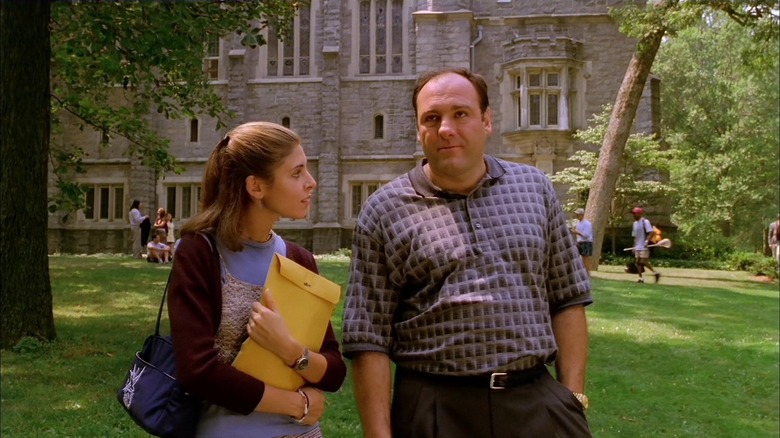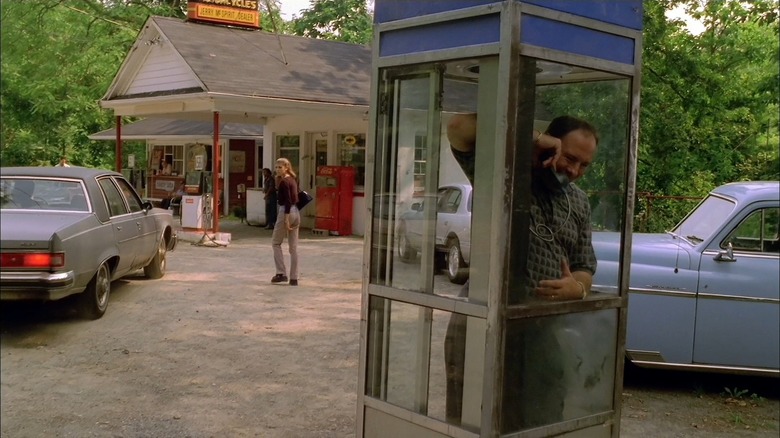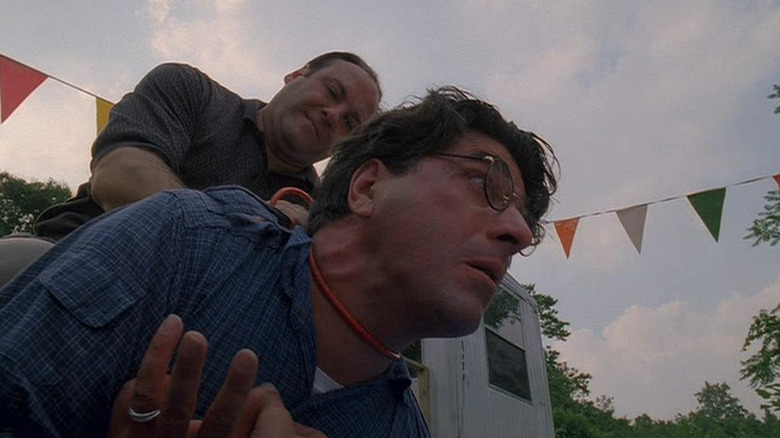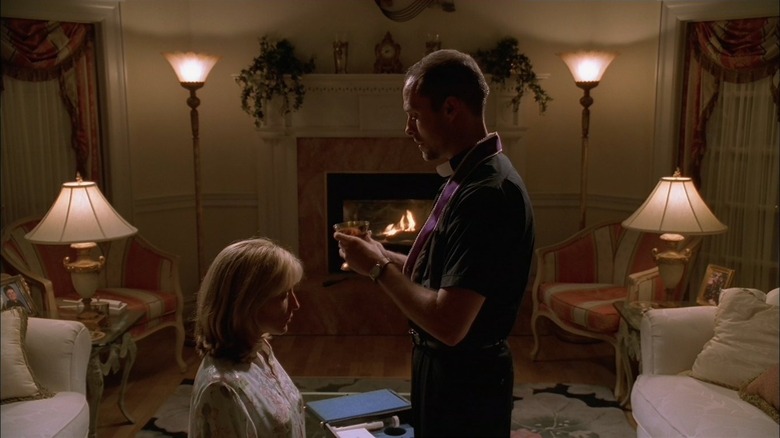The Sopranos' Signature Look Came From Ignoring The Rules Of TV
David Chase's "The Sopranos" absolutely blew audiences' minds when it hit the small screen in 1999. The series followed New Jersey mafioso Tony Soprano (James Gandolfini) and his associates as they tried to reconcile their old-world mafia lifestyle with suburban life at the turn of the millennium. The series was often at its best when it put mundanity and mobster business in contrast, and few episodes did it better than "College" from season 1. In the episode, Tony's daughter Meadow (Jamie-Lynn Sigler) wants to go look at colleges and her dear old dad takes her. She asks him point blank about his mob life, and he's surprisingly honest with her, though he turns around and lies to her when he's forced to kill a former associate during their little Maine road trip. The episode beautifully sets up Tony's double life, and the cinematography in the episode ended up setting a visual tone for the series that set it apart from so many of its contemporaries.
"The Sopranos" looks more like a movie than any other television show from the time period and helped to usher in the era of prestige television that gave us "Breaking Bad," "The Wire," and more. There's no better episode to show someone who's never seen "The Sopranos," as it's a brilliant introduction to everything that makes the series so great. "The Sopranos" changed the rules of television by ignoring them altogether, leaving its mark on the medium forever.
'I shot it as much as I could like a little movie'
The making of "The Sopranos" has been meticulously documented, and one of the best resources for learning about it is the book "Woke Up This Morning: The Definitive Oral History of the Sopranos," which is mostly transcribed from an accompanying podcast series hosted by "Sopranos" stars Michael Imperioli and Steve Schirripa. When the two discussed "College" with the episode's director, Allen Coulter, they learned that a big part of the series' style came from Coulter's lack of television experience. When Imperioli pointed out how much he loved the episode's camerawork, Coulter explained:
"What was an advantage to me was, I really hadn't done that much television, so I hadn't been indoctrinated in the way that people shoot TV. What I did was a minor-key variation on David [Chase, the series creator], who did all those years of television and then wrote 'The Sopranos.' I think, given his wonderful caustic nature and his deep cynicism, he somehow resisted being seduced by the world of television. That's why 'The Sopranos' looks nothing like television up until that point. I was not on that level, but I really didn't watch television. I shot it as much as I could like a little movie."
There are numerous handheld and perspective shots that put the audience in the character's perspective, and they give the episode a much more cinematic look. Coulter's direction is a little looser and a lot more experimental than most TV at the point, where a handful of standardized, still-camera shots were the flavor of the day. When you compare "The Sopranos" to its popular contemporaries like "The West Wing," the difference in creative vision is as clear as day. HBO commercials used to claim "It's not TV, it's HBO," and "The Sopranos" definitely lived up to being something more than simply television.
The beginning of prestige TV
The cinematic camerawork of "The Sopranos" helped usher in the era of "prestige TV," when creatives, critics, and audiences started taking television as seriously as they did movies. Allen Coulter's skills and unique style were so in-demand that he directed the pilots of "Nurse Jackie," "Damages," and "Sons of Anarchy," setting the visual tone for each of those shows and staking out a real claim in the television landscape. That's pretty impressive for someone who hadn't really worked on much television before "The Sopranos," and his influence on how TV dramas were shot is still felt to this day.
In "College," one half of the episode focuses on Tony as he deals with a former associate who went into witness protection, while the other half follows his wife Carmela (Edie Falco) while she has a surprisingly romantic night at home with her priest, Father Phil (Paul Schulze). The two stories are shot pretty differently, with Tony's half highlighting anxiety and horror while Carmela's half is almost sensuously sinister. When so many other shows felt nearly formulaic in their filmmaking, "The Sopranos" took big dramatic chances that paid off more than they didn't, and a big part of that is Coulter's influence. After "College," David Chase was so impressed that he hired Coulter on as an executive producer and had him direct 11 more episodes of the series.
Bringing big drama to the small screen
While Tony's scenes are incredibly shocking because he brutally kills a man, Carmela's are surprising as well because she nearly cheats on Tony with Father Phil. Michael Imperioli was impressed with the scene as well, and pointed out how "daring" it was to Allen Coulter, who explained that the intention was to shock people a little and it worked:
"In the communion scene with Carmela and father, there's the moment where he gives her the wafer, and I was feeling pretty loose. I said, "Let's do it in front of the fireplace, so it looks a little pornographic." The fact that she's on her knees, and the fire behind her, and he puts the wafer in her mouth. That quality that you're describing, Michael, really resonated with David. I know, because he told me. That's why he asked me to stick around."
It's a good thing that David Chase decided to keep Coulter around because he helped make "The Sopranos" one of the most compelling TV shows of all time. Sometimes taking risks turns into a huge reward, and for "The Sopranos," the greatest reward is being an important part of television history.



